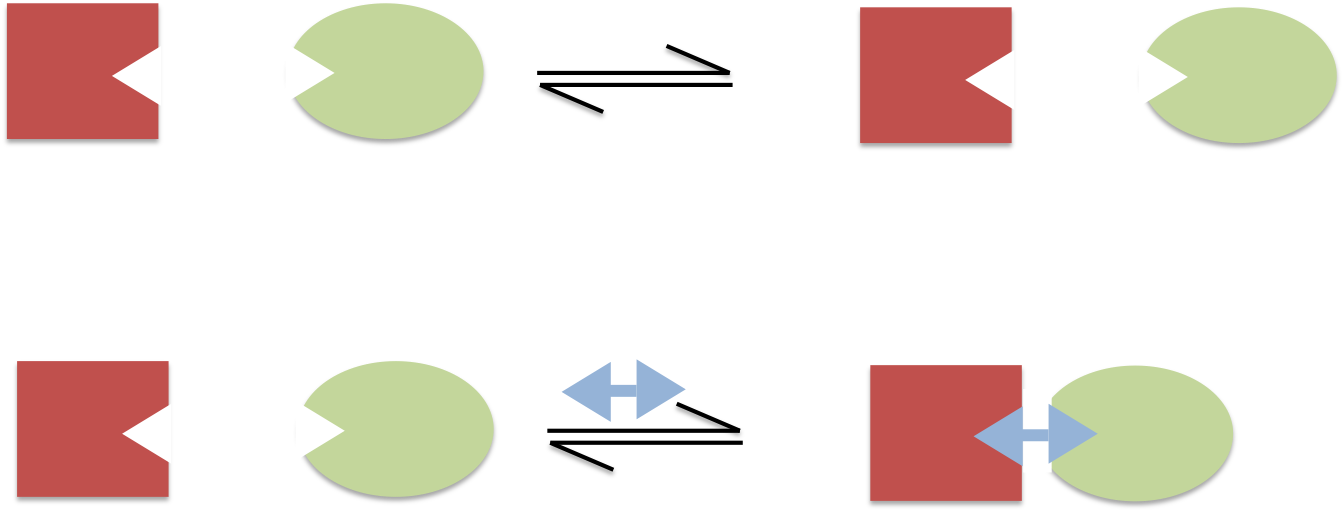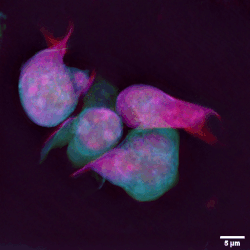|
FK506 Binding Protein
The FKBPs, or FK506 binding proteins, constitute a family of proteins that have prolyl isomerase activity and are related to the cyclophilins in function, though not in amino acid sequence. FKBPs have been identified in many eukaryotes, ranging from yeast to humans, and function as protein folding chaperones for proteins containing proline residues. Along with cyclophilin, FKBPs belong to the immunophilin family. FKBP1A (also known as FKBP12) is notable in humans for binding the immunosuppressant molecule tacrolimus (originally designated FK506), which is used in treating patients after organ transplant and patients with autoimmune disorders. Tacrolimus has been found to reduce episodes of organ rejection over a related treatment, the drug ciclosporin, which binds cyclophilin. Both the FKBP-tacrolimus complex and the cyclosporin-cyclophilin complex inhibit a phosphatase called calcineurin, thus blocking signal transduction in the T-lymphocyte transduction pathway. This therapeuti ... [...More Info...] [...Related Items...] OR: [Wikipedia] [Google] [Baidu] |
Autoimmune
In immunology, autoimmunity is the system of immune responses of an organism against its own healthy cells, tissues and other normal body constituents. Any disease resulting from this type of immune response is termed an " autoimmune disease". Prominent examples include celiac disease, diabetes mellitus type 1, Henoch–Schönlein purpura, systemic lupus erythematosus, Sjögren syndrome, eosinophilic granulomatosis with polyangiitis, Hashimoto's thyroiditis, Graves' disease, idiopathic thrombocytopenic purpura, Addison's disease, rheumatoid arthritis, ankylosing spondylitis, polymyositis, dermatomyositis, and multiple sclerosis. Autoimmune diseases are very often treated with steroids. Autoimmunity means presence of antibodies or T cells that react with self-protein and is present in all individuals, even in normal health state. It causes autoimmune diseases if self-reactivity can lead to tissue damage. History In the later 19th century, it was believed that the im ... [...More Info...] [...Related Items...] OR: [Wikipedia] [Google] [Baidu] |
FKBP3
FK506-binding protein 3 also known as FKBP25 is a protein that in humans is encoded by the ''FKBP3'' gene. Function The protein encoded by this gene is a member of the immunophilin protein family, which play a role in immunoregulation and basic cellular processes involving protein folding and trafficking. This encoded protein is a cis-trans prolyl isomerase that binds the immunosuppressants FK506 and rapamycin. It has a higher affinity for rapamycin than for FK506 and thus may be an important target molecule for immunosuppression by rapamycin. Interactions FKBP3 has been shown to interact with YY1, HDAC1, Histone deacetylase 2, DNA Deoxyribonucleic acid (; DNA) is a polymer composed of two polynucleotide chains that coil around each other to form a double helix. The polymer carries genetic instructions for the development, functioning, growth and reproduction of al ..., and Mdm2. Both crystal structure of FKBP25 with FK506 and the NMR structure of full lengt ... [...More Info...] [...Related Items...] OR: [Wikipedia] [Google] [Baidu] |
FKBP2
FK506-binding protein 2 is a protein that in humans is encoded by the ''FKBP2'' gene. Function The protein encoded by this gene is a member of the immunophilin protein family, which play a role in immunoregulation and basic cellular processes involving protein folding and trafficking. This encoded protein is a cis-trans prolyl isomerase that binds the immunosuppressants FK506 and rapamycin. It is thought to function as an ER chaperone and may also act as a component of membrane cytoskeletal scaffolds. This gene has two alternatively spliced transcript variants that encode the same isoform. Multiple polyadenylation sites have been described for this gene, but the full length nature of this gene has not been determined. Interactions FKBP2 has been shown to interact Advocates for Informed Choice, dba interACT or interACT Advocates for Intersex Youth, is a 501(c)(3) nonprofit organization advocating for the legal and human rights of children with intersex traits. The orga ... [...More Info...] [...Related Items...] OR: [Wikipedia] [Google] [Baidu] |
FKBP1B
Peptidyl-prolyl cis-trans isomerase FKBP1B is an enzyme that in humans is encoded by the ''FKBP1B'' gene. Function The protein encoded by this gene is a member of the immunophilin protein family, which play a role in immunoregulation and basic cellular processes involving protein folding and trafficking. This encoded protein is a cis-trans prolyl isomerase that binds the immunosuppressants FK506 (tacrolimus) and rapamycin (sirolimus). It is highly similar to the FK506-binding protein 1A. Its physiological role is thought to be in excitation-contraction coupling in cardiac muscle. There are two alternatively spliced transcript variants of this gene encoding different isoforms. Clinical significance Defective interaction between FKB1B and the ryanodine receptor is thought to be a potential mechanism underlying the arrhythmias seen in those with the genetic condition catecholaminergic polymorphic ventricular tachycardia Catecholaminergic polymorphic ventricular tachycardia ... [...More Info...] [...Related Items...] OR: [Wikipedia] [Google] [Baidu] |
FKBPL
FK506-binding protein like, also known as FKBPL, is a protein that in humans is encoded by the ''FKBPL'' gene. Function FKBPL has similarity to the immunophilin protein family, which play a role in immunoregulation and basic cellular processes involving protein folding and trafficking. The encoded protein is thought to have a potential role in the induced radioresistance. Also it appears to have some involvement in the control of the cell cycle. FKBPL is involved in cellular response to stress. It was first isolated in 1999 and was initially named DIR1. It was later reclassified because of its homology to the FKBP family of proteins and was renamed FKBP-like (FKBPL). A separate study that found it to be involved in the stabilisation of newly synthesised p21 termed it Wisp39. It is known to interact with Hsp90, glucocorticoid receptor and dynamitin and may play a role in signalling, like other FKBPs. FKBPL has also been shown to influence estrogen receptor signalling and c ... [...More Info...] [...Related Items...] OR: [Wikipedia] [Google] [Baidu] |
AIPL1
Aryl-hydrocarbon-interacting protein-like 1 is a protein that in humans is encoded by the ''AIPL1'' gene. The protein is a member of FKBP prolyl isomerase family. Function Leber congenital amaurosis (LCA) accounts for at least 5% of all inherited retinal disease and is the most severe inherited retinopathy with the earliest age of onset. Individuals affected with LCA are diagnosed at birth or in the first few months of life with severely impaired vision or blindness, nystagmus and an abnormal or flat electroretinogram. The photoreceptor/pineal -expressed gene, AIPL1, encoding aryl-hydrocarbon interacting protein-like 1, was mapped within the LCA4 candidate region. The protein contains three tetratricopeptide motifs, consistent with nuclear transport or chaperone activity. AIPL1 mutations may cause approximately 20% of recessive LCA. Interactions AIPL1 has been shown to interact with NUB1. See also * Aryl hydrocarbon * Aryl hydrocarbon receptor * AH receptor-inte ... [...More Info...] [...Related Items...] OR: [Wikipedia] [Google] [Baidu] |
AH Receptor-interacting Protein
AH receptor-interacting protein (AIP) also known as aryl hydrocarbon receptor-interacting protein, immunophilin homolog ARA9, or HBV X-associated protein 2 (XAP-2) is a protein that in humans is encoded by the ''AIP'' gene. The protein is a member of the FKBP family. Function AIP may play a positive role in aryl hydrocarbon receptor-mediated signalling possibly by influencing its receptivity for ligand and/or its nuclear targeting. AIP is the cellular negative regulator of the hepatitis B virus (HBV) X protein. Further, it's been known to suppress antiviral signaling and the induction of type I interferon by targeting IRF7, a key player in the antiviral signal pathways. AIP consists of an N-terminal FKBP52 like domain and a C-terminal TPR domain. Mutations and role in disease AIP mutations may be the cause of a familial form of acromegaly, familial isolated pituitary adenoma (FIPA). Somatotropinomas (i.e. GH-producing pituitary adenomas), sometimes associated with prolact ... [...More Info...] [...Related Items...] OR: [Wikipedia] [Google] [Baidu] |
Chemically Induced Dimerization
Chemically induced dimerization (CID) is a biological mechanism in which two proteins bind only in the presence of a certain small molecule, enzyme or other dimerizing agent. Genetically engineered CID systems are used in biological research to control protein localization, to manipulate signalling pathways and to induce protein activation. History The first small molecule CID system was developed in 1993 and used FK1012, a derivative of the drug tacrolimus (FK506), to induce homo-dimerization of FKBP. This system was used ''in vivo'' to induce binding between cell surface receptors which could not bind in the normal way because they lacked the transmembrane and extracellular domain. Addition of FK1012 to the cells caused signal transduction. Chemically induced dimerization systems Applications CID has been used for a number of applications in biomedical research. In most applications each dimerizing protein is expressed as part of a fusion construct with other proteins of inter ... [...More Info...] [...Related Items...] OR: [Wikipedia] [Google] [Baidu] |
FK1012
FK1012 is a dimer consisting of two molecules of tacrolimus (FK506) linked via their vinyl groups. It is used as a research tool in chemically induced dimerization applications. FK1012 is a chemical inducer of dimerization (CID) which makes the protein capable of dimerization or oligomerization of fusion protein Fusion proteins or chimeric (kī-ˈmir-ik) proteins (literally, made of parts from different sources) are proteins created through the joining of two or more genes that originally coded for separate proteins. Translation of this '' fusion gene'' ...s containing one or more FKBP12 domains. It is used in pharmacology to act as a mediator in the formation of FK506 dimer. FK506 binding proteins (FKBPs) do not normally form dimers but can be caused to dimerize in the presence of FK1012. Genetically engineered proteins based on FKBPs can be used to manipulate protein localization, signaling pathways and protein activation. References Further reading * {{cite journal, tit ... [...More Info...] [...Related Items...] OR: [Wikipedia] [Google] [Baidu] |
Lymphocyte
A lymphocyte is a type of white blood cell (leukocyte) in the immune system of most vertebrates. Lymphocytes include T cells (for cell-mediated and cytotoxic adaptive immunity), B cells (for humoral, antibody-driven adaptive immunity), and innate lymphoid cells (ILCs; "innate T cell-like" cells involved in mucosal immunity and homeostasis), of which natural killer cells are an important subtype (which functions in cell-mediated, cytotoxic innate immunity). They are the main type of cell found in lymph, which prompted the name "lymphocyte" (with ''cyte'' meaning cell). Lymphocytes make up between 18% and 42% of circulating white blood cells. Types The three major types of lymphocyte are T cells, B cells and natural killer (NK) cells. They can also be classified as small lymphocytes and large lymphocytes based on their size and appearance. Lymphocytes can be identified by their large nucleus. T cells and B cells T cells (thymus cells) and B cells ( bone marrow- ... [...More Info...] [...Related Items...] OR: [Wikipedia] [Google] [Baidu] |
Signal Transduction
Signal transduction is the process by which a chemical or physical signal is transmitted through a cell as a biochemical cascade, series of molecular events. Proteins responsible for detecting stimuli are generally termed receptor (biology), receptors, although in some cases the term sensor is used. The changes elicited by ligand (biochemistry), ligand binding (or signal sensing) in a receptor give rise to a biochemical cascade, which is a chain of biochemical events known as a Cell signaling#Signaling pathways, signaling pathway. When signaling pathways interact with one another they form networks, which allow cellular responses to be coordinated, often by combinatorial signaling events. At the molecular level, such responses include changes in the transcription (biology), transcription or translation (biology), translation of genes, and post-translational modification, post-translational and conformational changes in proteins, as well as changes in their location. These molecula ... [...More Info...] [...Related Items...] OR: [Wikipedia] [Google] [Baidu] |


